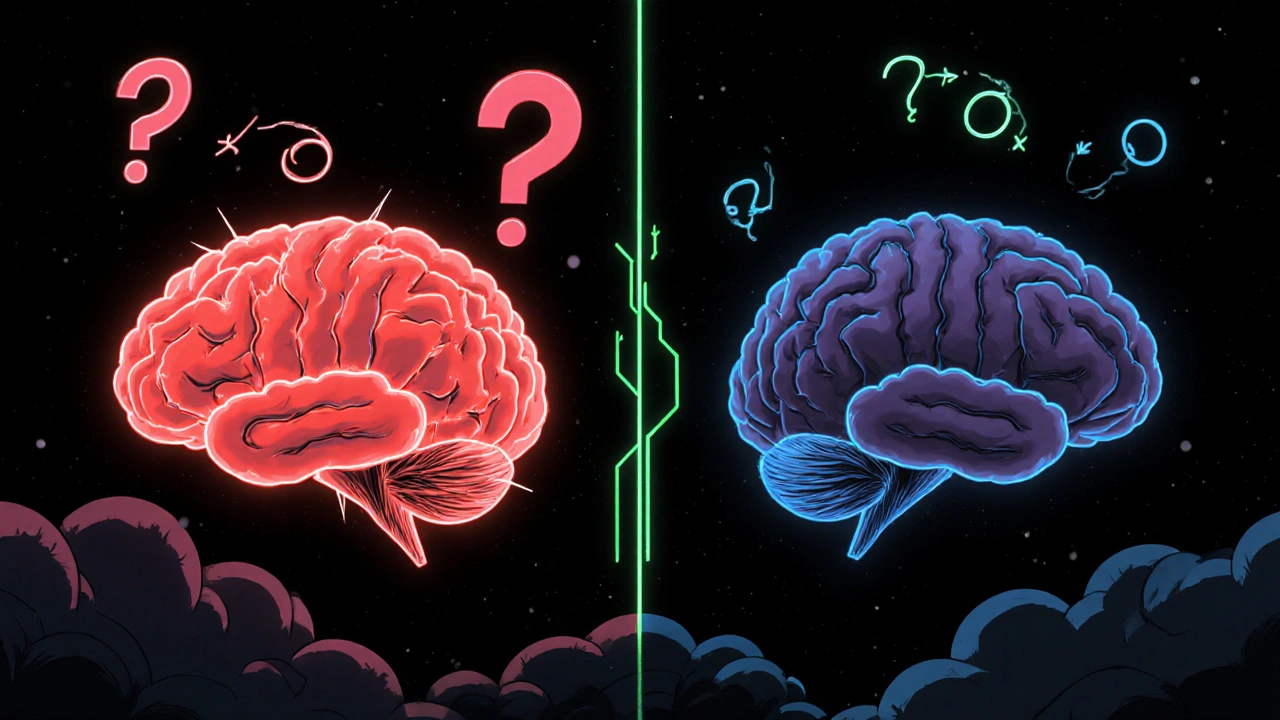When we talk about Anxiety is a state of excessive worry, tension, and physical symptoms such as a racing heart, restlessness, or trouble sleeping, we often hear it mentioned together with Depressive Disorder is a persistent feeling of sadness, loss of interest, and low energy that interferes with daily life. The two conditions don’t just co‑exist by chance; they share biology, thoughts, and even treatment paths. If you’ve ever wondered why a panic attack can turn into a low‑mood day, or why doctors talk about a “dual diagnosis,” this guide breaks down the science and the practical steps you can take.
Key Takeaways
- About 50% of people with anxiety also meet criteria for a depressive disorder, and the reverse is true for roughly 40%.
- Both conditions involve overlapping brain chemistry - especially serotonin, norepinephrine, and stress hormones like cortisol.
- Shared cognitive patterns (negative thinking, rumination) keep the cycle going.
- Integrated treatment-combining therapy, medication, and lifestyle changes-works best for co‑occurring cases.
- Early screening and self‑monitoring can catch the link before it spirals.
What Is Anxiety?
Anxiety isn’t just “being nervous.” It’s a chronic state where the brain’s alarm system stays on even when there’s no real danger. Physical signs include a fast heartbeat, muscle tension, and shallow breathing. Mentally, people feel on edge, have racing thoughts, and may avoid situations that trigger worry.
According to the World Health Organization, roughly 264 million adults worldwide experience an anxiety disorder each year. The condition can show up at any age, but the teen years and early adulthood are hotspots because of academic, social, and career pressures.
What Is Depressive Disorder?
Depressive Disorder (often called major depressive disorder) goes beyond feeling sad. It’s a deep, ongoing low mood that saps motivation, disrupts sleep, and can lead to feelings of worthlessness. Physical symptoms may include changes in appetite, fatigue, and aches that have no clear medical cause.
Global estimates place depression as the leading cause of disability, affecting more than 280 million people. Like anxiety, it can arise at any stage of life, though the early 30s see a noticeable rise, linked to career and family stressors.
Why Do Anxiety and Depression Co‑occur?
Researchers call the overlap “comorbidity.” In large‑scale surveys, about half of the people diagnosed with an anxiety disorder also meet the criteria for a depressive disorder. The reverse-people with depression also showing anxiety symptoms-happens in roughly 40% of cases. This isn’t a coincidence; several pathways tie the two together.
Shared Symptoms
- Sleep disturbances (insomnia or hypersomnia)
- Fatigue and low energy
- Difficulty concentrating
- Physical tension and aches
When a person experiences one set of symptoms, the other condition can sneak in, creating a feedback loop.
Biological Overlap
Both disorders involve neurotransmitter imbalances-especially serotonin, norepinephrine, and dopamine. Stress hormones like Cortisol rise during chronic worry, and prolonged high levels can impair mood regulation, making depression more likely.
Brain imaging shows that the Amygdala, which processes fear, is hyper‑active in anxiety, while the prefrontal cortex, responsible for planning and mood, often shows reduced activity in depression. When both areas are dysregulated, the mind gets stuck in a cycle of fear and hopelessness.

Psychological Pathways That Link the Two
Beyond biology, the way we think can glue anxiety and depression together.
- Rumination: Re‑playing worries over and over fuels both anxiety spikes and depressive gloom.
- Catastrophic thinking: Imagining the worst scenario escalates anxiety, while the belief that nothing will improve deepens depression.
- Avoidance behavior: Dodging stressful situations reduces immediate anxiety but reinforces a sense of helplessness, a core depressive thought.
These patterns are why cognitive‑behavioral therapy (CBT) targets both disorders simultaneously.
How Professionals Diagnose the Connection
Clinicians use structured interviews and questionnaires to spot co‑occurring anxiety and depression. Common tools include:
- Patient Health Questionnaire‑9 (PHQ‑9) for depressive symptoms.
- Generalized Anxiety Disorder‑7 (GAD‑7) for anxiety severity.
- Mini‑International Neuropsychiatric Interview (MINI) that flags both at once.
When scores on both scales are elevated, the provider will likely label the case as “Anxiety‑Depressive Disorder comorbidity” and craft a blended treatment plan.
Treatment Strategies for Co‑occurring Anxiety and Depression
Because the conditions share roots, the most effective care tackles them together.
Medication
Selective serotonin reuptake inhibitors (SSRIs) such as fluoxetine or sertraline raise serotonin levels and have proven benefits for both anxiety and depression. For some patients, a combination of an SSRI and a low‑dose benzodiazepine (short‑term) helps calm acute anxiety while the SSRI takes effect.
Other classes-serotonin‑norepinephrine reuptake inhibitors (SNRIs) and atypical agents like bupropion-are also options, especially if side‑effects become an issue.
Therapy
Cognitive Behavioral Therapy (CBT) is the gold standard. It teaches patients to identify and challenge negative thoughts, replace avoidance with gradual exposure, and practice coping skills that reduce both worry and low mood.
Other evidence‑based approaches include:
- Acceptance and Commitment Therapy (ACT) - focuses on mindfulness and values‑driven action.
- Interpersonal Therapy (IPT) - helps resolve relationship stressors that fuel both conditions.
Lifestyle and Self‑Help
Small daily habits can shift the brain chemistry enough to ease symptoms:
- Regular aerobic exercise (30 minutes, 3-5 times per week) boosts endorphins and reduces cortisol.
- Sleep hygiene - consistent bedtime, limited screens, and a dark room.
- Balanced diet rich in omega‑3 fatty acids, whole grains, and leafy greens.
- Mindfulness meditation - even 10 minutes a day lowers amygdala activation.

Common Pitfalls to Avoid
When dealing with two intertwined disorders, people often stumble into traps that keep the cycle alive.
- Self‑diagnosing: Relying on internet lists can miss nuances; a professional assessment is crucial.
- Treating only one condition: Using an anti‑depressant without addressing anxiety symptoms often leaves patients stuck.
- Skipping follow‑up: Medication dose adjustments and therapy progress need regular reviews.
- Isolating yourself: Social withdrawal worsens both anxiety and depression.
Quick Reference: Anxiety vs. Depressive Disorder
| Aspect | Anxiety | Depressive Disorder |
|---|---|---|
| Core feeling | Excessive worry, fear | Persistent sadness, emptiness |
| Physical signs | Fast heart rate, sweating, tremors | Fatigue, aches, appetite changes |
| Typical onset | Teen‑to‑early adult years | Late teens to 30s |
| Common treatments | SSRIs, CBT, exposure therapy | SSRIs, CBT, IPT, lifestyle changes |
| Shared symptoms | Sleep trouble, concentration issues | Sleep trouble, concentration issues |
Next Steps for You
If you recognize any of the overlapping signs, start with a simple self‑check: score yourself on the PHQ‑9 and GAD‑7 (both available as free printable PDFs). A total score above 10 on either scale suggests a professional evaluation.
Reach out to a primary care physician or a mental‑health clinician. Bring your scores, list of current meds, and a brief timeline of symptoms-this speeds up the diagnostic process.
While waiting for an appointment, try one lifestyle tweak: a 20‑minute brisk walk each morning. Track how your mood and worry levels change over the week. Small data points help you see progress and give your clinician concrete info.
Frequently Asked Questions
Can anxiety turn into depression?
Yes. Chronic anxiety keeps the stress system activated, raising cortisol levels and draining emotional reserves. Over time, this pressure can trigger the low mood, loss of interest, and hopelessness that define depression.
Do I need two separate diagnoses?
Clinicians usually note both conditions if criteria are met, because each has specific treatment recommendations. However, many treatment plans address both simultaneously, especially with SSRIs and CBT.
Are there medicines that treat both at once?
SSRIs such as sertraline, fluoxetine, and escitalopram are approved for both generalized anxiety disorder and major depressive disorder. They work by increasing serotonin, which helps regulate mood and anxiety.
What therapy works best for both?
Cognitive Behavioral Therapy (CBT) is the most evidence‑based approach. It teaches skills for challenging negative thoughts (depressive) and for reducing avoidance (anxiety). ACT and IPT are also useful complements.
How long does recovery take?
Recovery varies. Some people notice improvement in 4‑6 weeks after starting medication and weekly therapy. Others may need 6‑12 months, especially if symptoms have been present for years. Consistency and early intervention are key.

Monika Bozkurt
October 18, 2025 AT 22:06The neurobiological overlap you described aligns with the concept of transdiagnostic mechanisms, wherein serotonergic dysregulation serves as a common substrate for both affective and anxiety phenotypes. Moreover, the hyper‑active amygdala coupled with prefrontal hypo‑activation creates a feedback loop that exacerbates rumination and hyper‑vigilance. From a therapeutic standpoint, this justifies the preferential use of SSRIs as first‑line agents, given their ability to modulate both pathways. Finally, the integration of CBT with pharmacotherapy can target cognitive distortions while stabilizing neurochemical imbalances, thereby fostering a more resilient psychophysiological state.
Penny Reeves
October 31, 2025 AT 14:40One could argue that the article merely scratches the surface of the intricate psychodynamic interplay, neglecting the epistemological underpinnings of comorbidity. Still, the citation of prevalence rates feels adequately grounded.
Sunil Yathakula
November 13, 2025 AT 08:13i totally get how scary it feels when your heart races and you cant sleep, it s like your brain wont shut off. try keeping a simple journal of what triggers the panic and see if patterns emerge. also, short breathing exercises can calm the nervous system fast. remember you arent alone in this, many ppl battle the same cycle.
Catherine Viola
November 26, 2025 AT 01:46It is imperative to recognize that the dual‑diagnosis model is not merely a clinical convenience but a reflection of an underlying nosological continuum. Neglecting the intertwined pathophysiology may lead to suboptimal treatment stratification, particularly when considering the nuanced pharmacodynamic interactions of serotonergic agents.
sravya rudraraju
December 8, 2025 AT 19:20The intricate dance between anxiety and depressive disorders can be likened to a tightly wound spring that, when compressed from multiple angles, releases energy in unpredictable bursts. First, the chronic activation of the hypothalamic‑pituitary‑adrenal (HPA) axis elevates cortisol, which over time can erode hippocampal neurons, thereby impairing memory consolidation and mood regulation. Second, the persistent hyper‑vigilance characteristic of anxiety fuels a state of anticipatory dread, which in turn fuels rumination-a hallmark of depressive cognition. Third, neuroimaging studies reveal that the amygdala’s heightened response to threat cues is often accompanied by diminished activity in the ventromedial prefrontal cortex, reducing the brain’s capacity to exert top‑down control over emotional responses. Fourth, the serotonergic deficits implicated in both conditions result in a cascade of downstream effects, including diminished neurogenesis and altered synaptic plasticity, which perpetuate the cycle of low mood and heightened fear. Fifth, behavioral avoidance, while providing immediate relief from anxiety, paradoxically reinforces depressive helplessness by limiting exposure to rewarding experiences and social reinforcement. Sixth, lifestyle factors such as irregular sleep patterns and poor nutrition exacerbate neurochemical imbalances, creating a fertile ground for symptom amplification. Seventh, the presence of comorbid substance use can further destabilize neurotransmitter homeostasis, making standard pharmacological interventions less effective. Eighth, cognitive distortions-such as catastrophizing and black‑and‑white thinking-serve as bridges that translate anxious apprehensions into depressive hopelessness. Ninth, the bidirectional nature of the relationship means that improvement in one domain can catalyze recovery in the other; for example, successful anxiety management through exposure therapy often yields a secondary lift in mood. Tenth, clinicians should therefore adopt an integrated assessment approach, utilizing tools like the PHQ‑9 and GAD‑7 concurrently to capture the full spectrum of symptomatology. Eleventh, treatment plans that combine selective serotonin reuptake inhibitors (SSRIs) with cognitive‑behavioral strategies are empirically supported to address both neurochemical and cognitive contributors. Twelfth, adjunctive interventions such as aerobic exercise and mindfulness meditation have demonstrated efficacy in down‑regulating cortisol and enhancing prefrontal functionality. Thirteenth, early identification through routine screening in primary care settings can truncate the progression from isolated anxiety or depression to full‑blown comorbidity. Fourteenth, peer support groups provide a social buffer that mitigates isolation, a potent driver of depressive spirals. Finally, sustained follow‑up and dose titration are essential, as the therapeutic window for many psychotropics may shift as the brain gradually re‑establishes equilibrium. In sum, appreciating the multifaceted interplay between anxiety and depression empowers both clinicians and patients to adopt a holistic, proactive stance toward recovery.
Ben Bathgate
December 21, 2025 AT 12:53Looks solid, but I wonder if the piece could've dug deeper into the side‑effect profiles of the meds mentioned. Still, helpful overview.